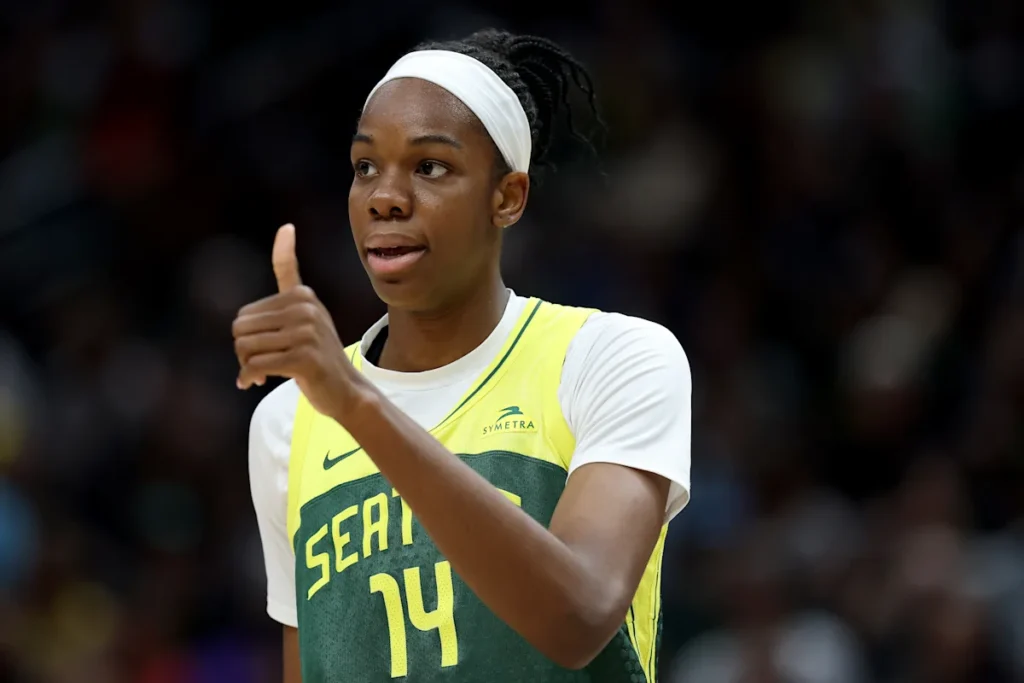In January 2024, in an effort to free up cap space needed to sign Nneka Ogwumike and Skylar Diggins, the Seattle Storm traded Kia Nurse and the No. 4 pick in the 2024 WNBA Draft to the Los Angles Sparks in exchange for the Sparks’ 2026 first-round pick. The Sparks selected Rickea Jackson with what would have been Seattle’s pick.
Now, what happens with the 2026 lottery pick the Storm own could determine whether Seattle or Los Angeles wins this trade. We might get a hint on Sunday, November 23 at 6:30 p.m. ET (ESPN) during the 2026 WNBA Draft Lottery, when the Storm will have a 16.7% chance of landing the top pick.
Advertisement
The Ogwumike-Diggins era of Storm basketball was mostly a disappointmentwith uneven regular seasons, clouded by reported internal turmoil, ending with two first-round eliminations in the playoffs. Although the Sparks have yet to post consistent wins, Jackson has established herself as a long-term piece with All-Star upside.
If the 2026 lottery pick comes in first overall, Seattle will certainly be in a stronger position to be declared the winner of the trade, regardless of which direction it chooses to take in 2026 under the leadership of new head coach Sonia Raman.
The organization could try to go back with Ogwumike and Diggins, along with as many other players as possible from their veteran group of Gabby Williams, Ezi Magbegor, Brittney Sykes and Erica Wheeler, and use the first pick to add a plug-and-play rookie. Or, they could prioritize retaining young veterans, namely Williams and Magbegor, and build a team that combines experience and youth, with the No. 1 pick joining 2025 No. 2 pick Dominique Malonga as a young, promising piece. Perhaps the franchise will choose a total reset, relying on a youth movement that prioritizes long-term development over a win-now approach, giving Raman, known for developing his players, the opportunity to build a team focused on maximizing Malonga and the No. 1 pick.
Here’s a look at the prospects Seattle should prioritize based on their orientation, plus a wildcard option:
Advertisement
If the Storm keep their veteran core, they should select….
UConn super senior guard Azzi Fudd
If Ogwumike and Diggins, in particular, remain in Seattle, a surefire shooter who can slide into a variety of lineup constructs makes sense. On a team looking to compete, Fudd would fit in without much fanfare. She wouldn’t need touches or prolonged opportunities to experiment with expanding her pan. She could just hit open shots and be a reliable enough cog on defense. Plus, she’s used to high-stakes standards and winning the championship.
If the Storm keep their young veterans, they should select…
Flau’Jae Johnson, LSU senior guard
If the organization only keeps its under-30 veterans in Williams and Magbegor, building an ultra-athletic team becomes an intriguing option. And among top prospects, Johnson would be best suited to reinforce such an identity.
Advertisement
Imagine a tandem of Williams and Johnson applying their elite athleticism on both ends of the court to frustrate their opponents. Disrupt passing lanes. Outpacing everyone in transition scores. Driving to the hoop in half court. Cut and slice for more open scores. Then, they would be supported by a back line consisting of Magbegor and Malonga, who could block the basket on one side while benefiting from the play of Williams and Johnson on the other.
If the Storm partners with a youth movement, they should select…
TCU super senior guard Olivia Miles
If the Storm decide it’s time to turn the page and embark on a Malonga-centric timeline and team, the need to set it up with a long-term backcourt partner. In this case, there’s no better choice than Miles, a creative point guard whose combination of passing instincts and improved shooting would help maximize the French phenom.
Advertisement
Malonga, likewise, could help Miles reach his highest score, as Malonga’s elite defensive traits could cover Miles’ projected weaknesses on that end.
If the Storm wants to zag, it must select…
UCLA Lauren Betts Senior Center
In recent seasons, more and more WNBA teams have prioritized modern space and pace systems that emphasize skill, speed and shooting over traditional size. In short, bigger is no longer synonymous with better.
But perhaps the storm could disrupt what has become conventional wisdom by getting bigger and, ultimately, better.
Twin towers (or Space Needle Sisters) of Malonga and Betts would be a bold team-building route, with the organization opting not to arm Malonga as a hyper-versatile 5, but instead opting to take advantage of her ability to play away from the basket as a 4 and pair her with an old(ish) school 5 in Betts. With the 6-foot-6 Malonga and the 6-foot-7 Betts, Seattle’s defense could be crazy, with Betts serving as a traditional rim protector while Malonga flies as a secondary rim protector, capable of crushing shots all over the floor. On the other hand, things might take longer, as Malonga is expected to become more proficient as a ball handler and 3-point shooter, while Betts is expected to demonstrate that her nascent midranger is reliable and can finish around the basket effectively at the pro level.

